
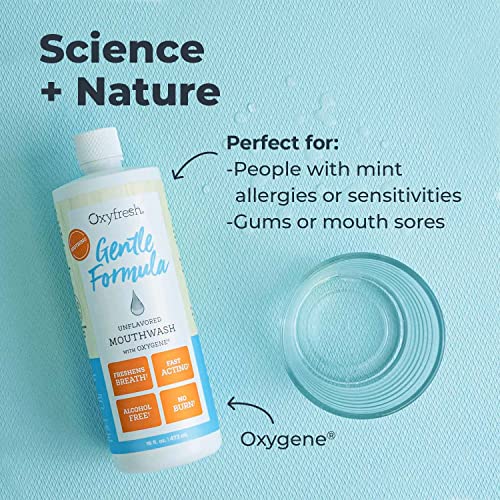
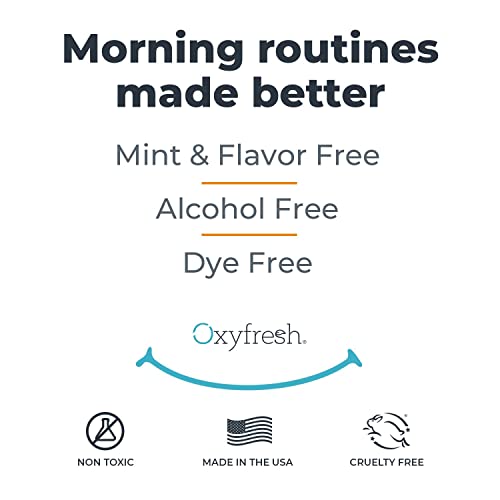
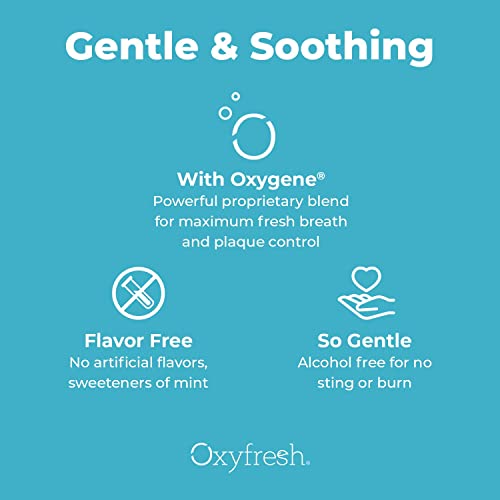
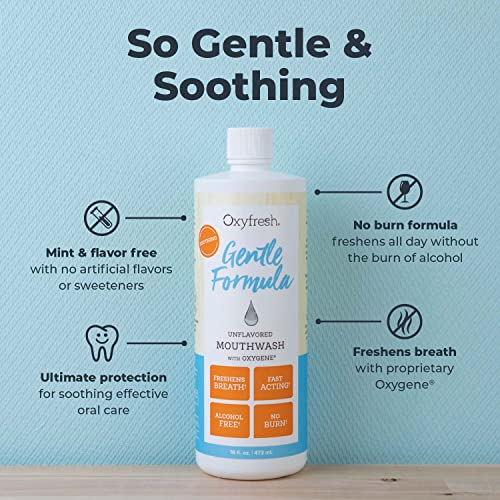
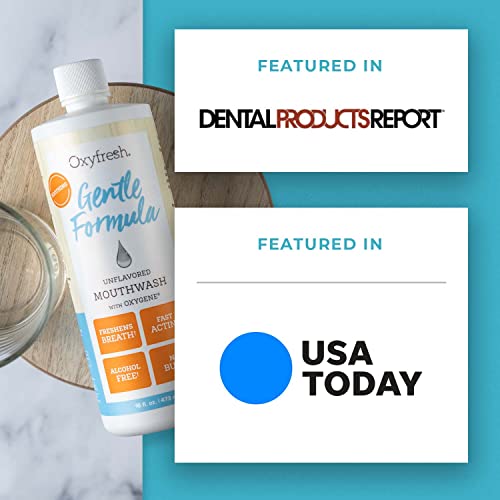
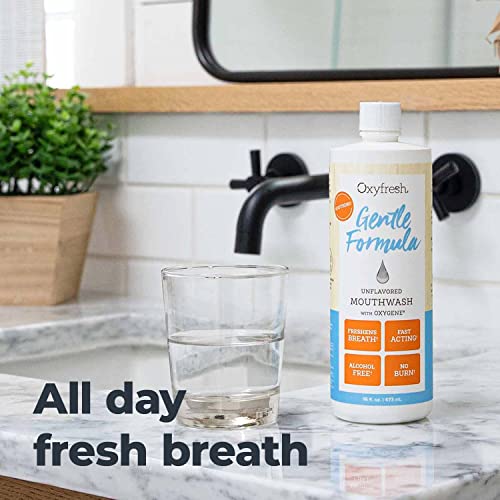
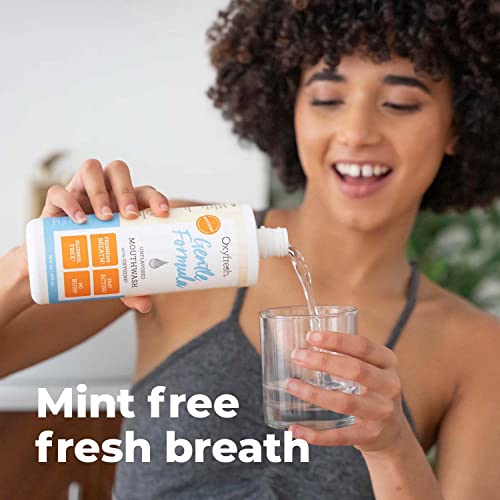
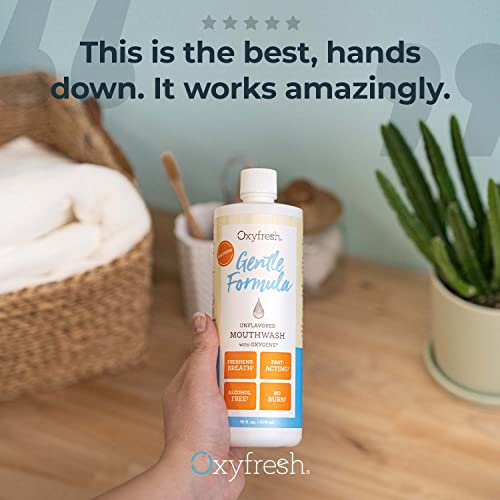
Oxyfresh Mouthwash - Gentle & Alcohol-Free for Sensitive Gums, Unflavored - 16oz


Sodium Hydroxide
High RiskSodium hydroxide is a highly caustic and reactive inorganic compound commonly used as a pH adjuster in various products. It is effective in neutralizing acids and plays a role in the production of soaps and detergents.
Sustai Insights
Sodium hydroxide serves essential functions, particularly in adjusting pH levels, but poses significant health risks, including skin and eye irritation. It is subject to high usage restrictions due to its corrosive nature. Environmental concerns include its potential to pollute water sources and contribute to ecosystem damage. Regulatory bodies have imposed strict guidelines on its use, indicating a high-risk profile for products containing this ingredient. Safe handling practices are crucial, and alternatives include milder pH adjusters, emphasizing the need for caution in its application.
Sodium Benzoate
Medium RiskSodium benzoate is a preservative commonly used in food and cosmetic products to prevent microbial growth and extend shelf life. It is derived from benzoic acid and is effective at low concentrations, often used in acidic environments like beverages and condiments.
Sustai Insights
Sodium benzoate serves effectively as a preservative, contributing to product stability and safety. It is generally recognized as safe with low concerns for carcinogenicity, allergies, and reproductive toxicity, though it faces moderate use restrictions in some regions. Environmental risks include its potential as a pollutant, but it does not bioaccumulate significantly. Regulatory bodies have issued advisories regarding its concentration in products. Overall, the risk level is assessed as medium, with safe usage practices recommended. Alternatives such as potassium sorbate may provide similar benefits with potentially lower restrictions.
Potassium Sorbate
Medium RiskPotassium sorbate is a potassium salt of sorbic acid, primarily used as a preservative in food and cosmetic products. It inhibits the growth of molds, yeast, and some bacteria, extending the shelf life of products. It is commonly found in various formulations due to its effectiveness and low toxicity.
Sustai Insights
Potassium sorbate serves as an effective preservative, preventing microbial growth in food and cosmetic products, which is vital for safety and longevity. Although it has a low risk of carcinogenicity and developmental toxicity, there is a moderate concern regarding allergies and immunotoxicity. Environmentally, it poses minimal risks as it is not significantly bioaccumulative. Regulatory agencies have verified its use, although some products may face restrictions. Overall, it is assessed as a medium risk ingredient, with safe usage practices recommended, and alternatives such as natural preservatives could be considered.
Potassium Phosphate
Low RiskPotassium phosphate is an inorganic salt commonly used in food and pharmaceutical products as a buffering agent, emulsifier, and nutrient source. It aids in maintaining pH balance and stabilizing formulations.
Sustai Insights
Potassium phosphate offers functional benefits such as effective pH regulation and nutrient provision. It has a low risk of health concerns, including low allergenic potential and no known carcinogenic effects. Environmentally, it poses minimal risks, with no significant pollutant potential. Regulatory bodies have not placed restrictions on its use. Overall, the risk associated with potassium phosphate is assessed as low, making it a generally safe ingredient. Safe usage practices should still be followed, and alternatives like sodium phosphate may be considered.
Water
Low RiskWater is a clear, colorless liquid essential for various biological processes. It serves as a solvent in formulations, facilitating the dissolution of other ingredients and enhancing product texture and application. Additionally, water plays a crucial role in hydration and is a key component in many cosmetic and personal care products.
Sustai Insights
Water is an effective solvent and hydrator, contributing to the texture and efficacy of formulations. It is biodegradable and generally regarded as safe, with low concerns regarding carcinogenicity, allergies, and reproductive toxicity. However, excessive water usage can lead to environmental concerns, particularly regarding resource depletion. Regulatory bodies do not impose restrictions on water use in cosmetics. Overall, the risks associated with water are low, making it a safe and essential ingredient.
Potassium Phosphate
Low RiskPotassium phosphate is an inorganic salt commonly used in food and pharmaceutical products as a buffering agent, emulsifier, and nutrient source. It aids in maintaining pH balance and stabilizing formulations.
Sustai Insights
Potassium phosphate offers functional benefits such as effective pH regulation and nutrient provision. It has a low risk of health concerns, including low allergenic potential and no known carcinogenic effects. Environmentally, it poses minimal risks, with no significant pollutant potential. Regulatory bodies have not placed restrictions on its use. Overall, the risk associated with potassium phosphate is assessed as low, making it a generally safe ingredient. Safe usage practices should still be followed, and alternatives like sodium phosphate may be considered.
Sodium Hydroxide
High RiskSodium hydroxide is a highly caustic and reactive inorganic compound commonly used as a pH adjuster in various products. It is effective in neutralizing acids and plays a role in the production of soaps and detergents.
Sustai Insights
Sodium hydroxide serves essential functions, particularly in adjusting pH levels, but poses significant health risks, including skin and eye irritation. It is subject to high usage restrictions due to its corrosive nature. Environmental concerns include its potential to pollute water sources and contribute to ecosystem damage. Regulatory bodies have imposed strict guidelines on its use, indicating a high-risk profile for products containing this ingredient. Safe handling practices are crucial, and alternatives include milder pH adjusters, emphasizing the need for caution in its application.
Sodium Benzoate
Medium RiskSodium benzoate is a preservative commonly used in food and cosmetic products to prevent microbial growth and extend shelf life. It is derived from benzoic acid and is effective at low concentrations, often used in acidic environments like beverages and condiments.
Sustai Insights
Sodium benzoate serves effectively as a preservative, contributing to product stability and safety. It is generally recognized as safe with low concerns for carcinogenicity, allergies, and reproductive toxicity, though it faces moderate use restrictions in some regions. Environmental risks include its potential as a pollutant, but it does not bioaccumulate significantly. Regulatory bodies have issued advisories regarding its concentration in products. Overall, the risk level is assessed as medium, with safe usage practices recommended. Alternatives such as potassium sorbate may provide similar benefits with potentially lower restrictions.
Water
Low RiskWater is a clear, colorless liquid essential for various biological processes. It serves as a solvent in formulations, facilitating the dissolution of other ingredients and enhancing product texture and application. Additionally, water plays a crucial role in hydration and is a key component in many cosmetic and personal care products.
Sustai Insights
Water is an effective solvent and hydrator, contributing to the texture and efficacy of formulations. It is biodegradable and generally regarded as safe, with low concerns regarding carcinogenicity, allergies, and reproductive toxicity. However, excessive water usage can lead to environmental concerns, particularly regarding resource depletion. Regulatory bodies do not impose restrictions on water use in cosmetics. Overall, the risks associated with water are low, making it a safe and essential ingredient.
Potassium Sorbate
Medium RiskPotassium sorbate is a potassium salt of sorbic acid, primarily used as a preservative in food and cosmetic products. It inhibits the growth of molds, yeast, and some bacteria, extending the shelf life of products. It is commonly found in various formulations due to its effectiveness and low toxicity.
Sustai Insights
Potassium sorbate serves as an effective preservative, preventing microbial growth in food and cosmetic products, which is vital for safety and longevity. Although it has a low risk of carcinogenicity and developmental toxicity, there is a moderate concern regarding allergies and immunotoxicity. Environmentally, it poses minimal risks as it is not significantly bioaccumulative. Regulatory agencies have verified its use, although some products may face restrictions. Overall, it is assessed as a medium risk ingredient, with safe usage practices recommended, and alternatives such as natural preservatives could be considered.
Discover the Oxyfresh Gentle Formula Unflavored Mouthwash, specially designed for individuals with ultra-sensitive gums and teeth. This alcohol-free, flavor-free mouthwash effectively neutralizes bad breath while providing a soothing experience. Ideal for those with mint or sweetener allergies, it ensures fresh breath confidence without any stinging or burning.
- Fresh Breath Confidence: Neutralizes bad breath effectively for all-day freshness.
- Alcohol-Free Formula: Gentle on sensitive mouths, offering a safe cleansing experience without irritation.
- Perfect for Allergies: Free from mint and sweeteners, making it suitable for allergy sufferers.
- Ultimate Protection: Helps protect and soothe your teeth and gums with each use.
- Trusted by Professionals: Crafted in the USA, this mouthwash is trusted by dental professionals for its quality and effectiveness.
Subscribe & Save with Sustai
- Best Price Guarantee: Always enjoy the lowest prices on sustainable home essentials.
- No Surprises: We’ll notify you before shipping. No hidden fees, ever.
- You’re in Charge: Change, pause, or cancel your subscription anytime with ease.
- Eco-Friendly Deliveries: Our grouped shipments mean less packaging and lower emissions.
Join us on a sustainable journey. Special offers for a limited time! Prices and promotions may change.
Recommended Products
Discover the Oxyfresh Gentle Formula Unflavored Mouthwash, specially designed for individuals with ultra-sensitive gums and teeth. This alcohol-free, flavor-free mouthwash effectively neutralizes bad breath while providing a soothing experience. Ideal for those with mint or sweetener allergies, it ensures fresh breath confidence without any stinging or burning.
- Fresh Breath Confidence: Neutralizes bad breath effectively for all-day freshness.
- Alcohol-Free Formula: Gentle on sensitive mouths, offering a safe cleansing experience without irritation.
- Perfect for Allergies: Free from mint and sweeteners, making it suitable for allergy sufferers.
- Ultimate Protection: Helps protect and soothe your teeth and gums with each use.
- Trusted by Professionals: Crafted in the USA, this mouthwash is trusted by dental professionals for its quality and effectiveness.

You can have at most 2 Sustainable Steals products in your cart
Customer Reviews
Customers’ View
Customers express strong satisfaction with the Oxyfresh Unflavored Mouthwash, particularly appreciating its gentle, alcohol-free formula that avoids the harsh sensations often associated with traditional mouthwashes. Many users highlight its suitability for those sensitive to mint or strong flavors, noting that it provides effective breath freshening without irritation. One customer shared that it alleviated symptoms related to Burning Mouth Syndrome, emphasizing its soothing properties. Additionally, the product's clean ingredient list resonates with health-conscious consumers, as it is free from artificial additives and gluten. Overall, customers find this mouthwash to be a reliable choice for maintaining oral hygiene in a gentle, health-conscious manner.
AI-generated from the text of customer reviewsThis product is rated 3.0 of 5.0 stars.
It has received 1 review.




